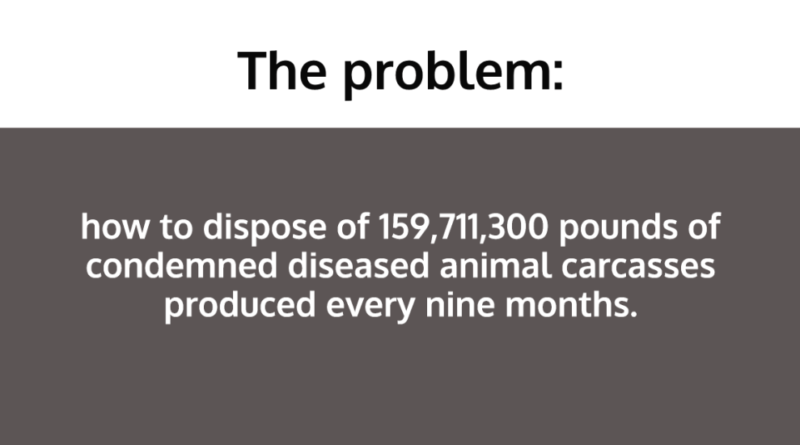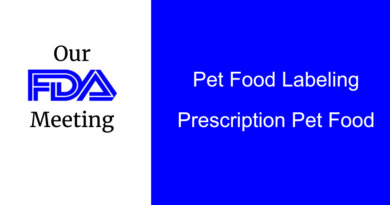The Huge Problem Solved By Pet Feed – Truth about Pet Food
The problem: how to dispose of 159,711,300 pounds of condemned diseased animal carcasses produced every nine months.
The solution: Pet Feed.
The FDA Center for Veterinary Medicine allows pet food (pet feed) manufacturers to source ingredients from “diseased animals and animals that have died other than by slaughter” with no disclosure to the consumer buying the pet food – this is a direct violation of federal law. Further, the FDA has no science to prove that pet food sourced from diseased animals or animals that have died other than by slaughter are safe for pets to consume (or for pet owners to bring into their home).
Why would a federal agency allow pet food to violate federal law? Why would FDA Center for Veterinary Medicine allow pet foods to source ingredients from diseased animals or animals that have died other than by slaughter with NO scientific evidence to prove their safety (or nutritional adequacy)? And why would the agency refuse to require pet foods to disclose to pet owners their use of illegal waste ingredients?
The last question is easy to answer – no pet owner would buy a pet food that was labeled ‘Made with Real Condemned Diseased Chicken’. And they (FDA) REALLY needs pet owners to buy pet foods made with condemned and/or non-slaughtered animal ingredients.
The answer to the other questions are explained when we learn how BIG the problem is.
The United States Department of Agriculture (USDA) is the federal agency that regulates meat. The agency approves healthy livestock carcasses, and condemns unhealthy diseased livestock carcasses. Healthy livestock carcasses become food/food ingredients, unhealthy diseased livestock carcasses are prohibited by USDA to become food/food ingredients.
From recently released USDA Data, for just nine months – October 2020 through June 2021 – the USDA inspected and passed 125,422,917 livestock carcasses (cattle and hogs) and 7,125,756,007 poultry carcasses (chickens and turkeys). All of these animal carcasses were approved for use in food.
The problem is how many animals were condemned during the same nine month time frame (October 2020 through June 2021). The USDA condemned 193,043 carcasses of livestock, and condemned 7,898,725 poultry carcasses.

If we assign an average weight of the livestock (cow and hog) carcasses at 500 pounds each, this equals 96,521,500 pounds of condemned livestock (in just nine months) that has to be disposed of.
If we assign an average weight of the poultry (chicken and turkey) carcasses at 8 pounds each, this equals 63,189,800 pounds of condemned poultry (in just nine months) that has to be disposed of.
Giving us a horrifying total of 159,711,300 pounds of condemned carcasses processed in just nine months – that has to be disposed of.
That’s equivalent to the weight of 53,000 cars – that needs to be disposed of every nine months.

Just imagine what a challenge it would be to dispose of all those pounds of condemned animal carcasses – the massive undertaking it would be to dispose of diseased animal carcasses that equal the weight of 53,000 cars.
We asked the USDA what happens to all of those condemned animal carcasses. The agency responded (FSIS stands for Food Safety Inspection Service – the division of USDA that inspects meat):
“FSIS mission is to ensure condemned materials are precluded from use as human food; FSIS does not regulate the condemned materials’ ultimate use. FSIS jurisdiction over condemned materials ends when the condemned materials leave the official establishment and enter commerce. Any condemned materials that are shipped from an official establishment and enter commerce must 1) have completed an on-site inedible rendering process, 2) be denatured, or 3) be shipped under permit issued by the district office and consigned to a manufacturer of other than human food.“
We also directly asked the USDA if the condemned animal carcasses are disposed of into pet food. They responded they do not regulate pet food ingredients and…
“please contact the FDA for a definitive answer since they regulate the raw materials used for animal food.”
In other words, it is soley FDA’s decision.
Reminder of a quote from FDA in response to our Citizen Petition (requesting the agency stop allowing diseased animal carcasses and non-slaughtered animal carcasses into pet food):
“we do not believe that the use of diseased animals or animals that died otherwise than by slaughter to make animal food poses a safety concern and we intend to continue to exercise enforcement discretion where appropriate.”
The decision of what to do with millions of pounds of condemned animal carcasses (every year) was made by FDA, or at least the decision was made by their “enforcement discretion” actions. The FDA Center for Veterinary Medicine decided by their actions that the best place to dispose of millions of pounds of diseased condemned animal carcasses was to dispose of them into pet food/animal feed with no disclosure to pet owners.
It’s a huge problem that becomes our problem.
Because FDA has decided to solve a disposal problem with pet food, the problem ends up being our (pet owners) problem. Which pet foods contain diseased condemned animals? Which pet foods contain non-slaughtered animals (not included in the totals above)?
In 2016, myself and a pet owner whose dog died from endotoxins in pet food were provided a meeting (phone meeting) with FDA. The following excerpt from that meeting applies to our problem.
If you don’t want pets to be living landfills, please tell the FDA to stop allowing pet food ingredients to be sourced from condemned diseased animal carcasses and non-slaughtered animal carcasses. At the very least, the FDA should require full disclosure on the pet food bag or can if the product contains this illegal, inferior quality of ingredient. Pet owners should be provided with full disclosure to the quality of ingredients in the pet food they purchase.
The FDA is hosting a “listening session” regarding their regulation of pet food on September 24, 2021. We have requested opportunity to speak during this meeting. Every pet owner can give FDA their opinions on pet food on the government website Regulations.gov. Click on the blue “Comment” button on the left top side.
The problem of waste disposal should NOT be solved through pet food.
The only type of pet food that gives us a guarantee to NOT include condemned carcasses is human grade pet food which is legally required to use food (not feed) ingredients (and is legally required to be manufactured per human food regulations). Look for the words “Human Grade” on the pet food label – ignore website claims. Some pet foods don’t meet the full requirements to be labeled as Human Grade, but do utilize 100% food ingredients. Ask your manufacturer if ingredients are food grade (human grade) or feed grade – don’t hesitate to ask them to provide you proof to quality of ingredients.
Wishing you and your pet(s) the best,
Susan Thixton
Pet Food Safety Advocate
Author Buyer Beware, Co-Author Dinner PAWsible
TruthaboutPetFood.com
Association for Truth in Pet Food

Become a member of our pet food consumer Association. Association for Truth in Pet Food is a stakeholder organization representing the voice of pet food consumers at AAFCO and with FDA. Your membership helps representatives attend meetings and voice consumer concerns with regulatory authorities. Click Here to learn more.
What’s in Your Pet’s Food?
Is your dog or cat eating risk ingredients? Chinese imports? Petsumer Report tells the ‘rest of the story’ on over 5,000 cat foods, dog foods, and pet treats. 30 Day Satisfaction Guarantee. Click Here to preview Petsumer Report. www.PetsumerReport.com
Find Healthy Pet Foods in Your Area Click Here

The 2021 List
Susan’s List of pet foods trusted to give her own pets. Click Here to learn more.




